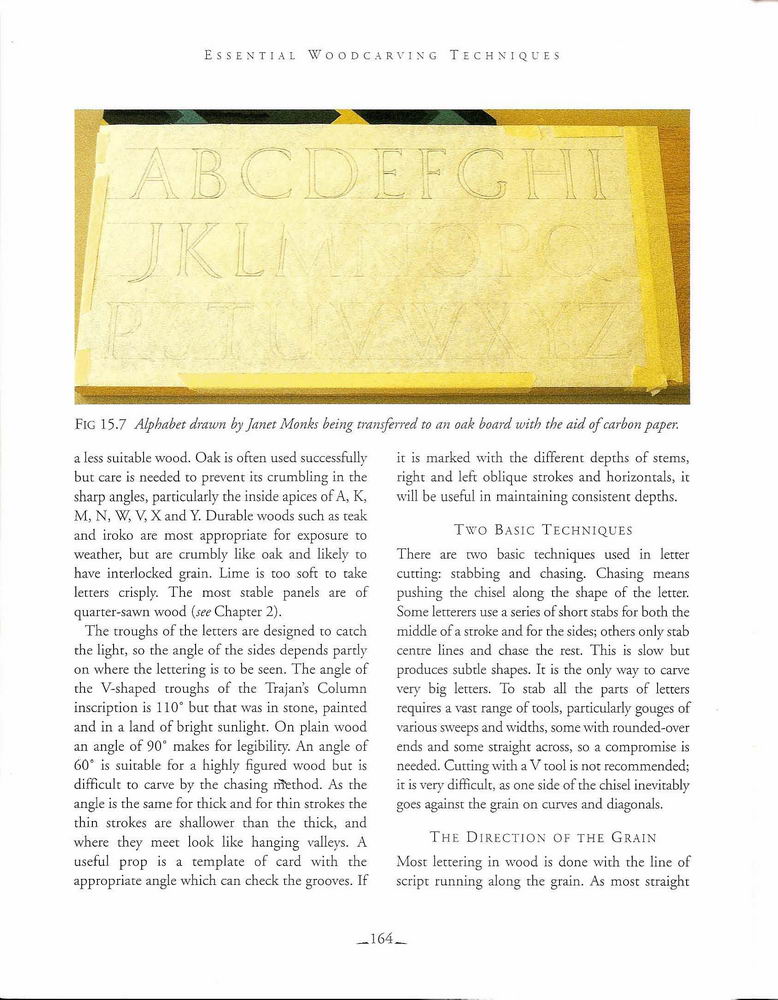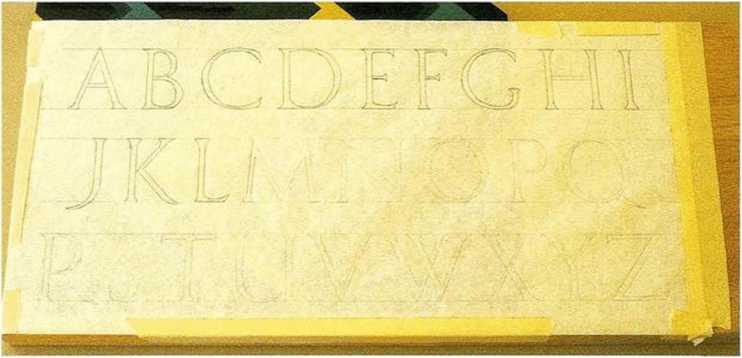essent╩rving▒64

ESSENTIAL W o O D C AR v1N G T E C H NIQ U E S

Fig 15.7 Alphabet drawn by Janct Monks being tramferred to an oak board with the aid of carbon paper.
a less suitable wood. Oak is often used successfully but care is needed to prevent its crumbling in the sharp angles, particularly the inside apices of A, K, M, N, W, V, X and Y. Durablc woods such as tcak and iroko are most appropriate for exposure to weather, but are crumbly like oak and likely to have interlocked grain. Lim─Ö is too soft to take letters crisply. The most stable panels are of quartcr-sawn wood {see Chaptcr 2).
The troughs of the letters are designed to catch the light, so the angle of the sides depends partly on where the lettering is to be seen. The angle of the V-shapcd troughs of the Trajans Column inscription is 110° but that was in stone, painted and in a land of bright sunlight. On plain wood an angle of 90° makes for legibility. An angle of 60® is suitable for a highly figured wood but is difficult to carve by the chasing rftethod. As the angle is the saine for thick and for thin strokcs the thin strokcs are shallower than the thick, and where they meet look like hanging vallevs. A useful prop is a template of card with the appropriate angle which can check the groove$. If it is marked with the different depths of srems, right and left oblique strokes and horizontals, it will be useful in maintaining consistent depths.
Two Basic Techniques
There are two basie techniques used in letter cutting: stabbing and chasing. Chasing mcans pushing the chiscl along the shape of the letter. Some lerterers use a series of short stabs for both the middle of a stroke and for the sides; others only stab centre lines and chase the rest. This is slow but produces subtlc shapes. It is the only way to carvc verv big letters. To stab all the parts of letters rcquires a vast rang─Ö of tools, particularly gouges of various sweeps and widths, some with rounded-over ends and some straight across, so a compromise is needed. Cutting with a V tool is not recommended; it is very difficult, as one side of the chisel inevitably goes against the grain on curves and diagonals.
The Direction of the Grain
Most lettering in wood is done with the lin─Ö of scripi running along the grain. As most straight
_164_
Wyszukiwarka
Podobne podstrony:
essent?rving?95 - C A R V I N G A COMMONPLACE OBJECT IN H I G H R; : .H Fig 8.15 Texturing the insid
essent?rving?66 E $ S F. X T I A L W O O D C A R V 1 N G T E C H X I Q U E S Fic 15.10 A gouge with
essent?rving?68 Essen tial Woodcarving Techniques FlG 15.16 The fint cut into the serif on an M. Fig
essent?rving?96 Essen ti al W o o dcaryinc T e c h niq u e s Fig S.18 Cutting across tbe gmin wbere
essent?rving?48 Essential W o o d c aR v
essent?rving?70 Es S E N TI A L W O O D C A R VING TeCHXIQUE$ Fig 15.23 The fishtail cutting the end
Chapter 13 Exam - IT Essentials: Sprzęt i oprogramowanie komputerów ®®0:15®:^ PC (Wersja 4.0)1 Dlacz
essent?rving?25 T O O L S AND EQUIPMENT (12o-20┬░) and maximum control (Fig 1.42). Frcqucncly inspect
essent?rving?49 First Cuts: Chip C a r v i n g Fig 3.9 A hole mad─Ö by rotating tbe No. 8 gotige whil
essent?rving?51 First Cuts: Chip C a r v i n g Fig 3.14 Startinga mor─Ö complex flower. The centre ri
essent?rving?52 EssenÔÇÖ tial W o o d c a r v i n g Techniques Fig 3.18 A No. 3 fishtail being used to
essent?rving?67 F O L I A G E : Co P V I N G A NT A T URAL L F. A F I N W O O D Fi
essent?rving?82 ESSENTIAL W o O D C A R VIXG T E C H N1Q U E S Fig 7.3 Drawings ofa linenfoldpatiem
essent?rving?15 Fig 10.16 The smali beech bowl being held in a caruers chops with a bar across its m
essent?rving?32 Essenti a i W o odcar yinc T k t h niq u e s Essenti a i W o odcar yinc T k t h niq
essent?rving?69 IN CI $ E D LETTERING FlC 15.21 Chasing a flared side to a stem with o skew chisel.
I Fig. 15. Th┬ę element* that form the electronics payload employed for the Project "Score."
wi─Öcej podobnych podstron